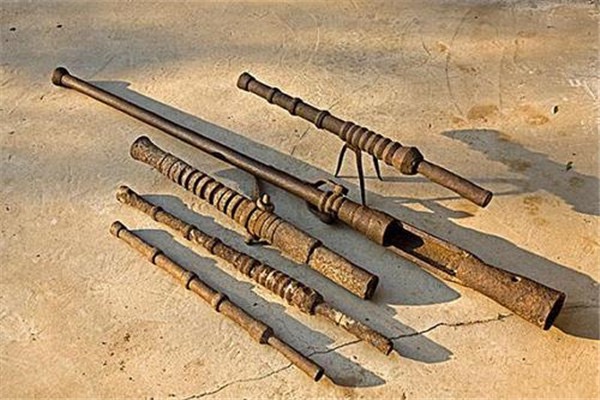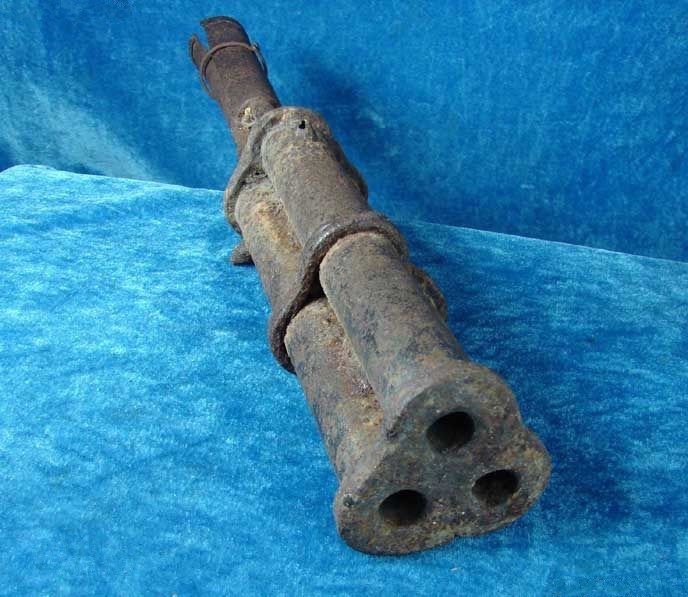In human history, firearms have played a pivotal role, radically altering the nature of combat and the development of various cultures. Let’s investigate where firearms came from and how they’ve developed over time.
Which country invented the gun?

When did the Chinese invent guns?Many different cultures have claimed credit for developing what is widely acknowledged as one of the most significant technological advancements in human history: the firearm. Nonetheless, most historians agree that the first gun-like weapon was developed in China some time around the 9th century AD.
The “fire lance,” a Chinese invention, was a crude handgun comprised of a bamboo tube packed with gunpowder and metal shards. The first firearms like this used largely as artillery against attacking armies.
Although the idea of employing explosive projectiles in battle was not new, the Chinese creation of the fire lance was a major advancement in military technology. Gunpowder was utilised as a propellant, and metal projectiles were incorporated, making this weapon more powerful than its forerunners like the Greek fire, which was used by the Byzantine Empire.
Guns have been refined and improved upon over the centuries, with new features being introduced by various cultures. For instance, the flintlock mechanism, which was developed in the 17th century, improved the reliability and use of guns in Europe.
In spite of this, the earliest known example of a gun-like weapon, the fire lance created in China, is widely seen as the forerunner to the handgun. Gunpowder’s origins and early dissemination are shrouded in mystery and folklore, but it’s certain that the Chinese were the first to investigate its possibilities as a military weapon.
Who invented the first gun?

Several people have different ideas about who invented the first gun and what it was used for, therefore it’s impossible to say for sure who came up with the idea originally. However the fire lance, developed by the Chinese in the ninth century AD, is generally acknowledged as the gun’s ancestor.
The fire lance was an extremely effective handgun that employed gunpowder and metal pellets. Even though the fire lance was very straightforward in its construction, it served as a crucial forerunner to more complex weaponry that came later. The weapon’s range and precision may be modified by altering the size and shape of the bamboo tube and the sharpness or shape of the metal projectiles.
Fire lances and other weaponry quickly became commonplace in China and the surrounding region. Arabs and Turks, among other cultures, quickly adopted gunpowder weapons and incorporated them into their own military strategy.
Although the Chinese discovery of the fire lance is usually cited as the first gun ever made, there are other possible inventors and developments that could have led to the evolution of weapons. For instance, Chen Gui, a military strategist from the Southern Song Dynasty, is credited with inventing the rifle in 1132. Gunpowder was supposedly first employed in weapons by Chen Gui, who is credited with inventing them after modifying previous weapons including the crossbow and flamethrower.
Several early gun-like weapons have been discovered in other parts of the world. The European hand cannon, which fired a metal ball propelled by gunpowder, was developed somewhere during the 14th century. In a similar vein, the tanegashima, a form of matchlock handgun, was first used in Japan during that century.
It’s important to remember that the gun wasn’t invented overnight; rather, it was the product of hundreds of years of refinement and discovery in the field of gunpowder. During the Tang Dynasty in China, fireworks and other types of amusement were the primary applications of gunpowder. But, its potential military applications were eventually discovered, and it was eventually incorporated into weapons such as the fire lance.
what was the first gun made out of?

Guns were probably built out of a wide range of materials in the beginning, with the choice depending on factors like design and manufacturing technology. Nonetheless, iron and bronze were the metals of choice for the earliest weapons.
Metal, often iron or bronze, was also used in the creation of the earliest European firearms like the hand cannon and the arquebus. The basic components of these early firearms were the barrel, the stock, and the trigger. It was common practise to forge the barrel from a single piece of metal by heating it and then shaping it with a hammer. Often oak or another hardwood was used to construct the stock, and it would be adorned with intricate carvings and inlays. A touch hole or a matchlock served as the firing mechanism, lighting the gunpowder to send the bullet hurtling down the barrel.
Bamboo tubes packed with explosives and shrapnel were used to create the earliest firearms, including the fire lances created in China in the 12th century. The shrapnel would be propelled out of the tube by the explosive power of the gunpowder, creating a deadly spray of shards. It’s likely that twine or other fibres were used to reinforce the bamboo tubes and increase their longevity.
The materials used to construct rifles shifted in accordance with advancements in firearms technology. New forms of steel, stronger and more durable than iron or bronze, were developed in the 19th century because to advancements in metallurgy. As a result, more sophisticated weaponry like the revolver and the repeating rifle were able to be created.
Steel, aluminium, titanium, and numerous synthetic materials are just some of the materials used in the production of modern weaponry. The materials used in a firearm are determined by a number of factors, including the manufacturer’s and the shooter’s personal preferences, as well as the firearm’s overall design and intended function.
What did the first gun look like?
Early firearms were rudimentary in construction, typically consisting of a metal tube with a touch hole or a matchlock mechanism to ignite the gunpowder. The early firearms took on a variety of forms, reflecting the cultural contexts in which they were developed.
Fire lances were the first firearms in China. They were made of bamboo tubes packed with gunpowder and shrapnel. It’s likely that twine or other fibres were used to reinforce the bamboo tubes and increase their longevity. A slow-burning fuse would light the gunpowder, sending the shrapnel hurtling out of the lance.
Early firearms in Europe were hand cannons and arquebuses. The gunpowder in hand cannons was ignited by touching the tube’s touch hole. It was common practise to forge the barrel from a single piece of metal by heating it and then shaping it with a hammer. The arquebus was a more complex firearm than the flintlock, featuring a metal barrel, wooden stock, and a matchlock mechanism to ignite the gunpowder.
The hand cannon and the arquebus were both unwieldy and inaccurate weapons with short ranges. On the other hand, they were a major technological leap forward for the military, enabling troops to launch attacks from farther away and with greater speed and efficiency than ever before.
What were the first guns used for?
The earliest firearms were put to military use, particularly in siege warfare and for protecting settlements from invaders. When compared against more conventional combat weapons like swords and spears, armies’ ability to fire projectiles from a distance was a decisive advantage.
During the Song Dynasty (960-1279), China produced its first guns, which were initially employed for self-defense. Soldiers utilised fire lances to fend off assailants, especially during siege operations.
Guns were initially invented in Europe about the 14th century and were used mostly by mercenaries and paid warriors. The use of hand cannons and arquebuses in battle and siege allowed soldiers to strike from a distance with greater speed and efficiency than ever before.
As weapons became more widely used in battle, military strategy and tactics underwent profound changes. As firearms improved, heavy armour became obsolete and light infantry tactics became the norm. Other forms of defence, like the star-shaped citadel, were also developed in response to the advent of gunpowder weaponry.
When were guns first used in war?

Gunpowder was originally used in battle in China around the 14th century. Cannons, fire lances, and rockets were just some of the gunpowder weapons utilised during the Ming dynasty (1368-1644) in its military battles.
Firearms were first used in battle somewhere during the 14th and 15th centuries in Europe. Early weapons were slow to load, difficult to aim, and had a short range; despite these drawbacks, they were useful in warfare and siege. Armed battles such as the Hundred Years’ War (1337–1453) and the Italian Wars saw the employment of hand cannons and arquebuses (1494-1559).
Guns were widely used in European wars by the 16th century. Infantrymen often carried muskets or pikes, while cannons were used to destroy enemy strongholds and advance. The introduction of gunpowder weaponry ushered in a new era of warfare characterised by the increased mobility and sophistication of opposing armies.
As weapons became more widely used in battle, military strategy and tactics underwent profound changes. Guns made heavy armour obsolete, and light infantry tactics became the norm. Other forms of defence, like the star-shaped citadel, were also developed in response to the advent of gunpowder weaponry.
Warfare’s widespread adoption of firearms had repercussions well beyond the battlefield. The invention of gunpowder weaponry hastened the demise of feudalism and the emergence of modern nation-states. It also sparked the development of new genres of art like still life and the landscape, which reflected the era’s preoccupation with the deadly potential of gunpowder weaponry and the ever-evolving nature of warfare.
What was the first gun used in war?
It’s hard to say for sure which culture used gunpowder weapons initially, as several different kinds were invented and put to use by militaries around the world.
Fire lances, the first gunpowder weapons in China, were used in defensive wars and sieges as early as the 10th century. The fire lance consisted of a bamboo cannon loaded with gunpowder and shrapnel and fired by a long fuse. In this scenario, the shrapnel would be driven from the tube, unleashing a lethal rain of metal shards.
The first guns used in battle in Europe were hand cannons, which were little more than basic tubes with a touch hole for lighting the gunpowder. It was common practice to forge the barrel from a single piece of metal by heating it and then shaping it with a hammer. Because proved effective against armour and fortifications, the hand cannon saw widespread usage in battle and siege operations throughout the 14th century.
The arquebus, a more advanced firearm introduced in the 15th century, replaced the pike as the primary weapon of infantrymen by the 16th century. The arquebus’s metal barrel was attached to a wooden stock, and the gunpowder was ignited using a matchlock. Its lead ball ammunition was efficient at long range and could even penetrate armour.
Other early firearms included cannons, used to destroy enemy positions and fortifications, and muskets, which superseded the arquebus as the primary weapon of infantry in the 17th century.
For the aforementioned reasons, it is safe to say that the development of firearms marked a watershed moment in human history, forever altering the face of conflict and the development of civilization. While early firearms were obviously crude compared to modern weapons, they did pave the way for the sophisticated weapons we have today.
